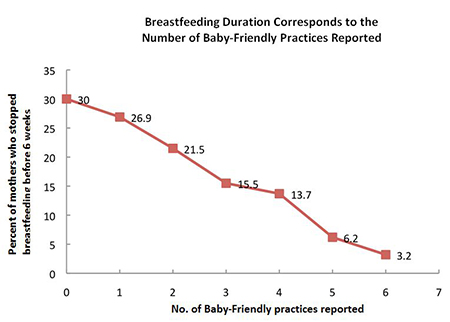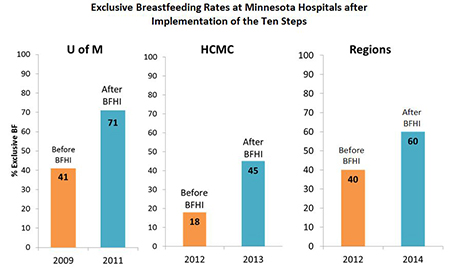Breastfeeding Information for Birth Centers
Birth Practices Can Have a Lasting Impact on a Child's Health
Hospital maternity care practices affect breastfeeding initiation, duration, and exclusivity and can have a lasting impact on a child’s health.
The vast majority of U.S. infants are born in a hospital. While their stay may be short, hospital maternity care practices affect breastfeeding initiation, duration, and exclusivity and can have a lasting impact on a child's health. Active support and promotion of breastfeeding by birth centers is essential if we are to meet the goals in Healthy Minnesota 2020 and Healthy People 2020.
Ten Steps to successful breastfeeding
In 1992, The World Health Organization and the United Nations Children's Fund launched the Baby Friendly Hospital Initiative to promote the adoption of the Ten Steps to Successful Breastfeeding, a list of maternity care practices shown to increase breastfeeding rates both in and out of the hospital. These steps have also been shown to reduce racial disparities in breastfeeding rates.
- Have a written breastfeeding policy that is routinely communicated to all health care staff.
- Train all health care staff in the skills necessary to implement this policy.
- Inform all pregnant women about the benefits and management of breastfeeding. For more information, see Baby-Friendly patient-education content.
- Help mothers initiate breastfeeding within one hour of birth.
- Show mothers how to breastfeed and how to maintain lactation, even if they are separated from their infants.
- Give infants no food or drink other than breast milk, unless medically indicated.
- Practice rooming in - allow mothers and infants to remain together 24 hours a day.
- Encourage breastfeeding on demand.
- Give no pacifiers or artificial nipples to breastfeeding infants.
- Foster the establishment of breastfeeding support groups and refer mothers to them on discharge from the hospital or birth center.
Research on the Ten Steps Program
Research supports the effectiveness of the Ten Steps program in increasing breastfeeding rates. Adopting even a few of these steps can increase breastfeeding rates, but larger effects are seen as more steps are adopted.
Among women who initiated breastfeeding and intended to breastfeed for >2 months, percentage who stopped breastfeeding before 6 weeks according to the number of Baby-Friendly Hospital Initiative practices they experienced.1
Minnesota hospitals that have implemented the Ten Steps to Successful Breastfeeding have seen dramatic increases in exclusive breastfeeding rates in a short period of time.
Learn More
1DiGirolamo AM et al. Pediatrics 2008;122:S43-S49.

